ECE36800 Programming Assignment 3
Assignment Description
You are required to implement a program to compute the signal delay of an RC (resistivecapacitive) tree, represented by a strictly binary tree. In a strictly binary tree, a non-leaf node always has two child nodes.
Every tree edge in the binary tree is a wire with some resistance and some capacitance. Consider a tree edge e = (u,v) of length le connecting a parent node u and to a child node v. The resistance and capacitance of the wire are given by
Re = r×le, Ce = c×le,
where r and c are per-unit-length resistance and per-unit-length capacitance, respectively. A firstorder model of the wire is given below:
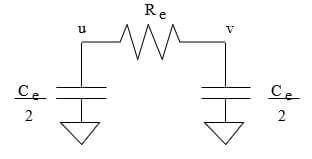
If the child node v happens to be a leaf node, it has an additional capacitance value associated with it, called the sink capacitance, denoted by cv. The corresponding circuit is given below:
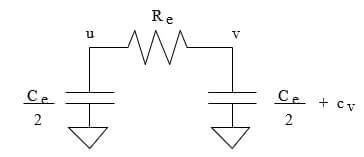
The tree is driven at its root by a driver (or buffer) with a output resistance rd. Therefore, the corresponding RC-tree of a binary tree is as follows:
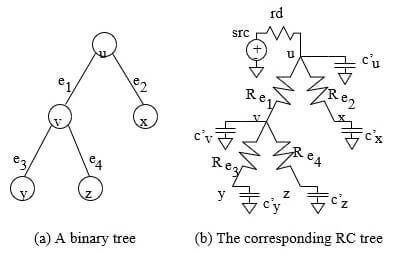
In the preceding figure, c0i corresponds to the total capacitance at node i. Therefore,
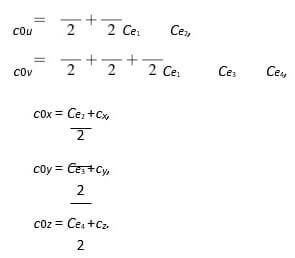
Moreover, the driver output resistance rd is between a source node, denoted as src and the root of the binary tree u. We can think of rd being the resistance of the edge (src,u).
Given an RC tree T, the following delay model gives an approximation of the delay from the source node src to node j. Let Path(src, j) denote the path in the tree from node src to
node j. Moreover, let RPath(src,i)∩Path(src,j) denote the total resistance along the path common to Path(src,i) and Path(src, j). The delay from src to j is given by the following expression:
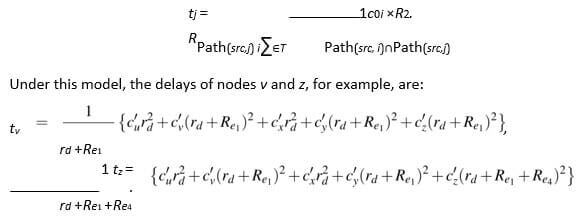
This delay model has an unusual property. The delays of nodes along the path from the source to a sink do not increase monotonically. For example, it is possible that tv is less than tz even though node z appears at the end of the path from src to z, and node v appears in the middle of the path.
For the delay model to be properly defined for all nodes in a tree, you may assume that the resistance rd is a strictly positive value.
Using an appropriate tree-traversal algorithm, the delay of a single node can be computed in O(n) time-complexity, where n is the total number of nodes in the RC tree. In fact, the delays of all nodes can be computed in O(n) time-complexity. In order to achieve that, it is important to analyze how tz can be computed from tv in the preceding example.
Deliverables
In this assignment, you are required to develop your own include file(s) and source file(s), which can be compiled with the following command:
gcc -std=c99 -pedantic -Wvla -Wall -Wshadow -O3 *.c -o pa3
It is recommended that while you are developing your program, you use the “-g” flag instead of the “-O3” flag for compilation so that you can use a debugger if necessary. All declarations and definition of data types and the functions associated with the data types should reside in the include file delay.h or source file delay.c. The main function should reside in the file pa3.c.
The executable pa3 would be invoked as follows:
./pa3 input filename output filename1 output filename2
The executable loads the RC tree from a file whose filename is given as input filename (note that the input filename can be any arbitrary valid filename; it is effectively the string stored as argv[1]), prints the topology of the RC tree in pre-order to a file whose filename is given as output filename1 (effectively, argv[2]), calculates the delay of all nodes in the tree, and print to a file whose filename is given as output filename2 (effectively, argv[3]) the delays of all leaf nodes.
Format of input file
The format of the input file specified by the input filename is as follows. The first line of the file contains three numbers (in the format of "%le %le %le\n"), where the first double specifies the output resistance at the source, rd (Ω), the second double specifies the per-unitlength resistance of a wire, r (Ω/unit-length), and the third double specifies the per-unit-length capacitance of a wire, c (F/unit-length).
The rest of the file is divided into lines, and each line corresponds to a node in the binary tree. The order in which the nodes are printed is based on a post-order traversal of the binary tree. If it is a leaf node (which is a sink), it has been printed with the format "%d(%le)\n", where the int is the label of the sink, and the double is the sink node capacitance (F). If it is a non-leaf node, it has been printed with the format "(%le %le)\n", where the first double is the wire length to the left child and the second double is the wire length to the right child.
Format of first output file
The first output file is a pre-order printing of the given RC tree. Each line corresponds to a node in the binary tree. If it is a leaf node (which is a sink), you print the node with the format "%d(%le)\n", where the int is the label of the sink, and the double is the sink node capacitance (F). If it is a non-leaf node, you print with the format "(%le %le)\n", where the first double is the wire length to the left child and the second double is the wire length to the right child.
Format of second output file
The second output file contains a pre-order printing of the delays of the leaf nodes of the given RC tree in the binary format. For each leaf node, you write the label (int) and the delay (double). The file size of the second output file should be the number of leaf nodes multipled by the sum of sizeof(int) and sizeof(double).
Electronic Submission
The project requires the submission (electronically) of the C-code (source and include files) through Blackboard. You should create and submit a zip file called pa3.zip, which contains the .h and .c files. Your zip file should not contain a folder.
zip pa3.zip *.c *.h
You should submit pa3.zip to Blackboard.
If you want to use a makefile for your assignment, please include the makefile in the zip file. If the zip file that you submit contains a makefile, we use that file to make your executable (by typing make at the command line to create the executable called pa3).
Grading
The assignment will be graded based on the two output files produced by your program, evaluated using sample files that are randomly generated. The first output accounts for 40 points and the second output accounts for 60 points. It is important that your program can accept any legitimate filenames as input or output files. Even if you cannot produce the second output file correctly, you should still write the main function such that it produces a valid first output file and an empty second output file so that you can earn partial credit.
It is important all the files that have been opened are closed and all the memory that have been allocated are freed before the program exits. Memory errors or any errors reported by valgrind will result in a 40-point penalty.
What you are given
You are given 5 sample input files (3.txt, 5.txt, 10.txt 100.txt, 1000.txt) and two sets of sample output files (3.pre, 3.delay, 5.pre, and 5.delay). The file 3.txt corresponds to the 3-sink example used in this document, with leaf nodes x, y, and z being labeled as 1, 2, and 3, respectively. The file 3.pre corresponds to the pre-order printing of this example, and 3.delay corresponds to the pre-order printing of the delays of sink nodes of this example. Similarly, 5.pre and 5.delay are the pre-order printings of all nodes and of all sink delays of the example in 5.txt, respectively.
To help you get started, we also provide you 3.delay.txt and 5.delay.txt, which are the labels and delays of sink nodes (in pre-order) in text format. In these files, each line corresponds to a sink and its delay. Each line is printed with the format "%d(%le)\n", where the int is the node label, and the double is the node delay. (While developing your program, you probably want to print the second output file in this manner. When you are confident of the correctness of your program, you would then write to a binary file the node labels and delays.)
10.txt, 100.txt, and 1000.txt contain examples of 10 sinks, 100 sinks, and 1000 sinks, respectively. Note that you should not assume that you can deduce the size of the RC tree based on the filename.
Additional information
As this assignment involves floating point computation, it is unlikely that your results will match my results exactly. We will allow for some minor discrepancies between your results and my results.
Check out the blackboard website for any updates to these instructions.

